|
|
|
Sort Order |
|
|
|
Items / Page
|
|
|
|
|
|
|
| Srl | Item |
| 1 |
ID:
104091
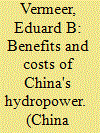

|
|
|
|
|
| Publication |
2011.
|
| Summary/Abstract |
During the past few years, the Chinese government has formulated ambitious plans for building many large hydropower stations, but so far it has withheld final approval for the construction of the majority. The environmental problems and rising cost of coal-fired stations, China's Copenhagen commitment, the creation of a high-voltage national power grid, and the availability of cheap capital should have all worked to the advantage of hydropower. Moreover, present projects require much less resettlement than those in previous decades. However, since 2006 political concern for the social problems of forced migration and distrust of the business alliance between power companies and provincial governments seem to be obstacles. Stricter regulations for environmental impact assessment, more comprehensive planning of water and reservoir use, and a lack of staff have lengthened approval processes. Central and provincial governments do not agree on developmental priorities and electricity prices. Uncertainty about obligations imposed on investing power companies is a factor too. Thus, hydropower policy suffers from conflicting goals and uneven commitment of various bureaucratic interests. Even if a clear policy commitment could improve policy implementation, China's target of 330 GW of regular hydropower capacity in 2020, and thereby its renewable energy target, are unlikely to be met.
|
|
|
|
|
|
|
|
|
|
|
|
|
|
|
|
| 2 |
ID:
139283
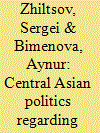

|
|
|
|
|
| Summary/Abstract |
This article analyzes the situation regarding the water resources of the transboundary rivers that developed in Central Asia after the collapse of the Soviet Union when the previous mechanism of mutual account of the interests of all the Central Asian republics broke down. Particular attention is given to studying the factors that have an impact on the formation and implementation of Central Asian politics regarding water use. A comparison is made of the international legal base that regulates conflicts involving the water resources of transboundary rivers and the legal documents of the Central Asian states. The paper analyzes the reasons for the failure to create a multisided mechanism for resolving the disputes that arise among the Central Asian countries with respect to water use of the transboundary rivers.
|
|
|
|
|
|
|
|
|
|
|
|
|
|
|
|
| 3 |
ID:
104582
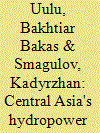

|
|
|
| 4 |
ID:
120209
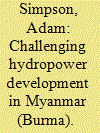

|
|
|
|
|
| Publication |
2013.
|
| Summary/Abstract |
Although general elections in Myanmar (Burma) in November 2010 have transformed the political landscape, many of the characters remain the same. While there is evidence of incremental domestic political openings many of the political constraints that existed during military rule remain in force. As a consequence of decades of military authoritarian governance and civil conflict, it is Myanmar's contested ethnic borderlands that have been the important locales for the development of environmental movements, despite increased recent domestic activity. This article analyses a case study of the largely cross-border campaign against hydropower dams on the Salween River in Myanmar and finds that through the suppression of opposition and dissent at home the regime has stimulated the creation of an 'activist diaspora', a dynamic transnational community of expatriates who engage in environmental activism beyond the reach of the regime. Due to their relative freedom on the border and in Thailand this community has developed expertise and international networks that have proved crucial in communicating the social and environmental impacts of hydropower development in Myanmar to the international community. Through increased cooperation with an expanding domestic civil society this established activist community is stimulating improved environmental governance of hydropower development and simultaneously assisting in the creation of a more open and democratic Myanmar.
|
|
|
|
|
|
|
|
|
|
|
|
|
|
|
|
| 5 |
ID:
092792


|
|
|
|
|
| Publication |
2009.
|
| Summary/Abstract |
The complementarity of two renewable energy sources, namely hydro and wind, is investigated. We consider the diversification effect of wind power to reduce the risk of water inflow shortages, an important energy security concern for hydropower-based economic zones (e.g. Québec and Norway). Our risk measure is based on the probability of a production deficit, in a manner akin to the value-at-risk, simulation analysis of financial portfolios. We examine whether the risk level of a mixed hydro-and-wind portfolio of generating assets improves on the risk of an all-hydro portfolio, by relaxing the dependence on water inflows and attenuating the impact of droughts. Copulas are used to model the dependence between the two sources of energy. The data considered, over the period 1958-2003, are for the province of Québec, which possesses large hydro and wind resources.
Our results indicate that for all scenarios considered, any proportion of wind up to 30% improves the production deficit risk profile of an all-hydro system. We can also estimate the value, in TW h, of any additional one percent of wind in the portfolio.
|
|
|
|
|
|
|
|
|
|
|
|
|
|
|
|
| 6 |
ID:
101184


|
|
|
| 7 |
ID:
166451


|
|
|
|
|
| Summary/Abstract |
This work discusses the development of hydropower in four Southeast Asia countries. With rapid economic development and insufficient energy supply, hydropower, as an important clean energy, plays a bigger role than before. It is shown that hydropower has immense potential and is the best choice to cater for the energy demand in Southeast Asia. In this work, Malaysia, Indonesia, Thailand and Myanmar are selected to analyze their hydropower development. This work introduces the status of hydropower resources, the current situation of hydropower development and the main distribution of hydropower stations in the four countries. In addition, the paper also introduces some energy policies, the development advantages and obstacles of the four countries, and puts forward suggestions for the future hydropower development of these four countries.
|
|
|
|
|
|
|
|
|
|
|
|
|
|
|
|
| 8 |
ID:
111421


|
|
|
|
|
| Publication |
2012.
|
| Summary/Abstract |
Climate warming is expected to alter hydropower generation in California through affecting the annual stream-flow regimes and reducing snowpack. On the other hand, increased temperatures are expected to increase hydropower demand for cooling in warm periods while decreasing demand for heating in winter, subsequently altering the annual hydropower pricing patterns. The resulting variations in hydropower supply and pricing regimes necessitate changes in reservoir operations to minimize the revenue losses from climate warming. Previous studies in California have only explored the effects of hydrological changes on hydropower generation and revenues. This study builds a long-term hydropower pricing estimation tool, based on artificial neural network (ANN), to develop pricing scenarios under different climate warming scenarios. Results suggest higher average hydropower prices under climate warming scenarios than under historical climate. The developed tool is integrated with California's Energy-Based Hydropower Optimization Model (EBHOM) to facilitate simultaneous consideration of climate warming on hydropower supply, demand and pricing. EBHOM estimates an additional 5% drop in annual revenues under a dry warming scenario when climate change impacts on pricing are considered, with respect to when such effects are ignored, underlining the importance of considering changes in hydropower demand and pricing in future studies and policy making.
|
|
|
|
|
|
|
|
|
|
|
|
|
|
|
|
| 9 |
ID:
166709


|
|
|
|
|
| Summary/Abstract |
The distributed nature of many renewable energy technologies allows for new ownership models as well as frequent ownership changes. We analyse whether a change in ownership negatively affects community attitudes toward a hypothetical small-scale hydropower plant. We use a two-stage framing experiment and a student sample. We find that a change in ownership has a significant negative effect on their attitudes toward the project, irrespective of whether the change is from a national to a local owner or vice versa. We interpret this finding as an example of a status quo bias, that is, a preference for the current state of affairs. A status quo bias makes renewable energy transitions more challenging, at least initially. Over time, as the status quo shifts, this may become less of an issue. We conclude the paper by discussing the robustness of our findings as well as whether and how policymakers can reduce the impact of such cognitive biases.
|
|
|
|
|
|
|
|
|
|
|
|
|
|
|
|
| 10 |
ID:
104654


|
|
|
|
|
| Publication |
2011.
|
| Summary/Abstract |
The present energy crisis in Bangladesh is partly due to over-dependence on gas which fulfils more than 70 per cent of its energy needs. The present gas deficit against the national demand on a daily basis is expected to increase further in the future. The crisis will deepen unless a greater share of indigenous coal is included in the energy mix. The geological and social constraints of an over-populated fertile agricultural land area remain an obstacle to large-scale coal mining and this has to be addressed rationally. In the absence of other immediate energy options, the potential of the country to address its energy problem lies in full-scale gas exploration and coal exploitation programmes, both of which are yet to mature. Bangladesh should also look for energy cooperation with its neighbours for energy trade and energy infrastructure development.
|
|
|
|
|
|
|
|
|
|
|
|
|
|
|
|
| 11 |
ID:
112521


|
|
|
| 12 |
ID:
118096


|
|
|
| 13 |
ID:
131224


|
|
|
| 14 |
ID:
094302


|
|
|
|
|
| Publication |
2010.
|
| Summary/Abstract |
Electricity trade across regions is often considered welfare enhancing. We show in this paper that this should be reconsidered if environmental externalities are taken into account. We consider two cases where trade is beneficial, before accounting for environmental damages: first, when two regions with the same technology display some demand heterogeneity; second when one region endowed with hydropower arbitrages with its "thermal" neighbor. Our results show that under reasonable demand and supply elasticities, trade comes with an additional environmental cost. This calls for integrating environmental externalities into market reforms when redesigning the electricity sector. Two North American applications illustrate our results: trade between Pennsylvania and New York, and trade between hydro-rich Quebec and New York.
|
|
|
|
|
|
|
|
|
|
|
|
|
|
|
|
| 15 |
ID:
166436


|
|
|
|
|
| Summary/Abstract |
Hydroelectricity provides approximately 65% of Brazil's power generating capacity, making the country vulnerable to droughts, which are becoming increasingly frequent. Current energy law and policy responses to the problem rely on a sectorial approach and prioritise energy security and market regulation. Brazil has opted to increase energy security levels during periods of hydrological variability with national grid interconnection and thermal plants backup. Additionally, Brazil has created the Energy Reallocation Mechanism (MRE) to manage the generators’ financial impacts in times of insufficient water. This policy, however, was unable to avoid the high financial exposure of generators in the spot market during the severe droughts experienced in the period 2012–2016.
|
|
|
|
|
|
|
|
|
|
|
|
|
|
|
|
| 16 |
ID:
111515
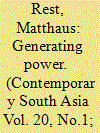

|
|
|
|
|
| Publication |
2012.
|
| Summary/Abstract |
Contested since 1990, the Arun-3 dam in Nepal has so far generated more heat than hydropower involving a host of complex negotiations between its advocates and critics on the local, national and transnational levels. Cancelled after a complaint before the World Bank Inspection Panel in 1995, work is soon to be resumed. An Indian public sector company interested in exporting the electricity to India will finance it. This paper focuses on how local communities have experienced the decade-long uncertainties concerning the project and the approach road to be built. Their hopes of access to markets, electrification and a modern lifestyle will be explored in the context of an understanding of development as a desiring machine and governmentality studies. I will argue for a parallel application of the two approaches to conceptualize the entanglement of desires for development and a deep sense of local powerlessness vis-a-vis external actors.
|
|
|
|
|
|
|
|
|
|
|
|
|
|
|
|
| 17 |
ID:
141621


|
|
|
|
|
| Summary/Abstract |
This paper studies environmental norm contestation in Cambodia's hydropower sector, exemplified by the Kamchay Dam. In Cambodia we can observe different discourses in relation to hydropower. These stem directly from a local contest over the path of Cambodia's development, but use global norms as reference points: one emphasizes environmental protection, using environmental impact assessment (EIA) as point of reference; and one emphasizes the utility of the clean development mechanism (CDM) to attract large-scale investment into the energy sector while downplaying the need for environmental protection. While EIA and CDM are complementary, key actors present them as contradictory. This produces a normative fragmentation of the field of environmental protection. The paper argues that the norm diffusion literature, by presenting norm conflicts as hierarchical local–global conflicts, has paid insufficient attention to the fact that local actors actively draw on global norms to justify domestic development policies. More emphasis on this phenomenon will lead to a better understanding of the role of global norms in domestic politics and will enhance our knowledge of how domestic development policies are contested.
|
|
|
|
|
|
|
|
|
|
|
|
|
|
|
|
| 18 |
ID:
174833


|
|
|
|
|
| Summary/Abstract |
At least 88 new hydropower dams are planned between 2010 and 2030 in the lower Mekong River basin in Southeast Asia as a source of electricity with lower greenhouse gas emissions. Dams result in declines in fish populations that will need to be replaced with other sources of protein for food security. We make the first assessment of emissions should beef production substitute for lost fish in Cambodia and Laos. We assessed two sources of emissions. Replacing lost fish with beef would require as much as 12 million hectares of new pasture. Forest clearing for pastures in Cambodia and Lao PDR would initially emit between 0.859 and 3.015 giga‐tonnes of carbon dioxide equivalents (Gt CO2‐eq.). Methane emissions from additional cattle would add at least 0.0013 Gt CO2‐eq./year to Cambodia's total greenhouse gas emissions, equivalent to a 20% increase. In Laos at least 0.0005 Gt CO2‐eq./year would be released, a 4–12% increase in annual emissions. We demonstrate that activities displaced by hydropower developments could significantly increase emissions. It shows how enclosure of commons at local scales impacts upon other common pool resources at different scales, raising questions for sustainable and equitable transboundary governance.
|
|
|
|
|
|
|
|
|
|
|
|
|
|
|
|
| 19 |
ID:
126501
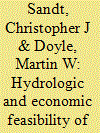

|
|
|
|
|
| Publication |
2013.
|
| Summary/Abstract |
The integration of hydropower facilities on existing low-head, non-Federal dams and their subsequent tie to regional electricity grids may serve as a useful de-centralized component of renewable energy integration in the United States. Thousands of low-head dams do not provide power and thus present few benefits with significant costs, including safety liability, fragmentation of river ecosystems, and persistent economic burden induced on state agencies due to regular inspection requirements. We conducted a feasibility study in the Piedmont region of North Carolina cataloguing over 1000 non-Federal dams with hydraulic head ranging from 4.6 m to 10.7 m (15 ft to 35 ft) and power capacity <300 kW ("micro" hydropower). Generation potential, greenhouse gas reductions, and financial viability were refined for 49 low-head dams over a 30-year life cycle using industry standard software (RETScreen4). Results suggest that most of these dams are not financially viable for energy production under cost structures evaluated at the time of this study. However, our results indicate that some low-head dams may be viable for energy production if provided funding opportunities comparable to the concurrent wind and solar markets.
|
|
|
|
|
|
|
|
|
|
|
|
|
|
|
|
| 20 |
ID:
098106
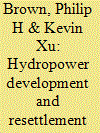

|
|
|
|
|
| Publication |
2010.
|
| Summary/Abstract |
Hydropower represents an important alternative form of energy in China, a country that currently uses coal to supply 78% of its electricity. However, evidence from large hydropower projects in China shows that the socio-economic and environmental costs of hydropower development are substantial. Construction on the first of the 13 planned dams on the Nu River began in the summer of 2008, and villages are already beginning to be displaced. Based on fieldwork in the area, we find that the local resettlement policies infringe upon the national regulations governing resettlement caused by major infrastructure development. This infringement includes high prices for resettlement homes, forcing villagers to leave agricultural production, a lack of programs for long-term economic development, and a lack of transparency in decision-making processes.
|
|
|
|
|
|
|
|
|
|
|
|
|
|
|
|
|
|
|
|
|